SUNY Geneseo
SUNY Geneseo (visited 3/9/20)
 If you’re looking for a medium sized school with strong academics, an active and engaged student body, and lots of things to do on and off campus – all at an affordable price-point, this is a school you want to take a closer look into. It seems to offer the best of all worlds.
If you’re looking for a medium sized school with strong academics, an active and engaged student body, and lots of things to do on and off campus – all at an affordable price-point, this is a school you want to take a closer look into. It seems to offer the best of all worlds.
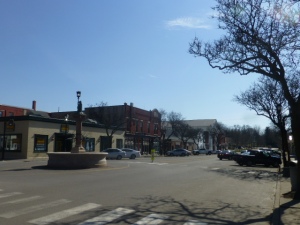
Main Street running by campus with Emmaline the Bear on the pole of the fountain – keep reading for more information on her!
The town of Geneseo is smaller than I anticipated (but is listed as having a population of 10,000+ so not tiny!) – but that doesn’t mean there’s not stuff to do. The town caters to students. Main Street, with a myriad of restaurants, bars, and cafes, runs right along campus. Chain stores like Target are about 1.5 miles from campus and buses run out there about every 20 minutes.
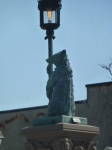
Closeup of Emmaline
Outdoorsy students will not be at a loss for options: Letchworth State Park (the “Grand Canyon of the East”) is 20 minutes away, and there are plenty of trails, waterfalls, ski resorts and other things around. For students wanting more urban options, Rochester (with a million people in the greater metro area) is only 35 minutes north of campus and Buffalo/Niagara Falls is a little over an hour away. However, the frequent on-campus events (including cool sounding events like the “Insomnia Film Festival”) mean that there’s never a shortage of things to do.
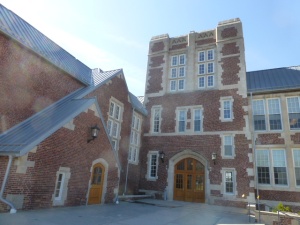
The old High School, now housing Admissions, study spaces, and more
Campus is great. The college does a great job repurposing as well as updating buildings; the old town high school and elementary schools are on campus, upgraded and used for a variety of things (like the admissions office is in the old high school). “It’s kind of cool to be in the old elementary school with the lockers in the hall!” said the tour guide. They’re currently in the middle of a massive $25m renovation of the library that’s expected to take a few years. They had to move things out of the building and got creative with how they’ve spread resources and study spaces across campus. When I arrived at Admissions, there were several students studying in lounge full of couches and windows (and a Keurig!) outside of the office; I asked the tour guide if this was normal. He said that this is one of many study new spaces popping up around campus for students to use while the library is being worked on.
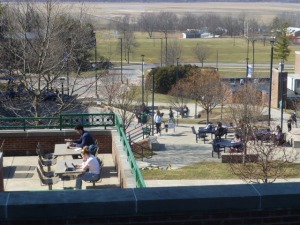
Some of the patios and other outdoor spaces, overlooking part of the valley in the distance. The Gazebo is directly to the right from this vantage point.
The rep, herself a Geneseo alumna, said, “the undergrad population [about 5,500 students] is the star of the show here.” There are only 100 grad students on campus in two programs, accounting and education. “We’re not a research institution per se, but we do the same types of research as peer institutions, and undergrads are doing it because there grad students aren’t here.”
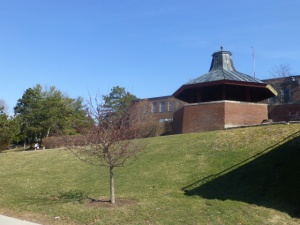
The Gazebo
They have a 90% FT faculty rate so there are fewer adjuncts; “it’s much easier to meet outside of the classroom,” said the tour guide. He loves the access to the professors. Upperclassmen can serve as TAs but don’t ever teach; they tutor and give extra help for recitations and exam prep. Most programs also provide Learning Centers for students. “We won’t have them for the smallest things like Biophysics, but those students will go to bio or physics for help,” he said.
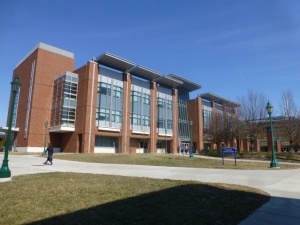
The Integrated Science Center
Geneseo is fairly well known for its sciences and have put a lot of money into its new Integrated Science Center. They’re ranked in the top 10 for alumni who’ve gone on to get doctorates in STEM fields (and physics in particular). They’re even the only school in Western New York with a Pelletron particle accelerator!
They do offer some impressive academic offerings, particularly for a school of this size, and they have some interesting interdisciplinary majors. A few to take note of are:
-
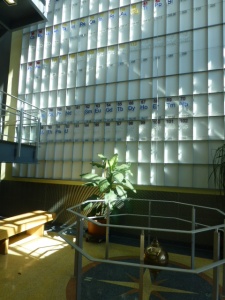
The Science Center atrium (with a wall displaying the periodic table)
Sociomedical Sciences: I can’t think of another school off the top of my head that offers this, although I’m sure that some of the large schools probably do. This combines biology, psychology, anthropology, sociology – all the background students will need for careers in areas like bioinformatics, public health, health admin, or health services.
- Geophysics, Geochemistry, Biophysics, and Biochemistry
- Black Studies
- Theater & English (yes, a combined degree) – again, I don’t know of another school that specifically does this (although I’ve seen theater as a concentration in English).

The tour guide wasn’t entirely sure what was going on with the statues over the door, but they’re a fun addition to the room!
My tour guide was in International Relations major, and he said that he felt that the non-science majors are also very strong here. “They’re setting us up for success. We have a lot of opportunities here.” The IR students have to study abroad; my tour guide was heading to Holland for a month. “I don’t speak the language, but I imagine that I’ll pick some up. I did it because the class sounds great!” They have an extensive study abroad program – particularly since students can access the entire SUNY system to choose programs if Geneseo doesn’t offer something they’re interested in.
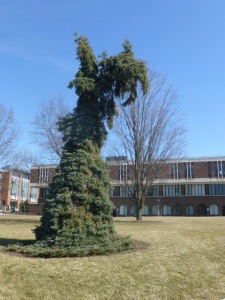
The Seuss Spruce
I asked the tour guide about his favorite classes:
- He took one on Woody Guthrie (who influenced him and who he influenced). “I love music and am a big Woody Guthrie buff, so this was great.”
- He said he also loved his Geology class that, admittedly, he took to fulfill a requirement but ended up loving it. “Every Thursday at 8am, I was out hiking in the woods right near campus. The professor got us outside a lot. We did water samples and all sorts of stuff.”
 Athletics are another bragging point, with a lot of their teams (all but 2 last year) qualifying for post-season tournaments. I wish I had more time so I could’ve checked out the stables used for the Equestrian Program. These are located less than a mile from campus so they’re easily accessible. The students do need to be there a certain number of hours a week for practice and maintenance, but students can work around their class schedule. The college will also be adding a women’s golf team in fall of 2020.
Athletics are another bragging point, with a lot of their teams (all but 2 last year) qualifying for post-season tournaments. I wish I had more time so I could’ve checked out the stables used for the Equestrian Program. These are located less than a mile from campus so they’re easily accessible. The students do need to be there a certain number of hours a week for practice and maintenance, but students can work around their class schedule. The college will also be adding a women’s golf team in fall of 2020.

The Greek Tree
A few cool traditions or interesting trivia about campus include:
- The Seuss Spruce which has become the (unofficial?) icon of the college. “It got damaged in a storm, and the college was going to take it down, but the students protested and they left it up,” my tour guide explained.
- The Bell tower plays every couple hours. “You hear some weird stuff coming out of there!”
- Greek Tree: “It’s got years worth of paint on it. It used to be tradition that they’d paint as far up as they could go, but you can see that kind of fell by the wayside!”
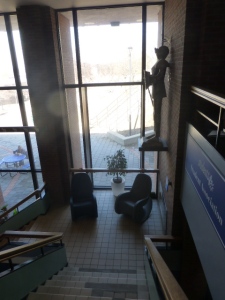 Signing a Knight: Seniors get to sign a suit of armor that is then displayed on campus.
Signing a Knight: Seniors get to sign a suit of armor that is then displayed on campus.- The Gazebo: people go there to watch the sunset across the valley. They’ve been named the top 10 sunset-watching spot!
- Emmaline the Bear: This actually isn’t on campus; it stands on a fountain on Main Street. It had been there for about 100 years without any incident; about 10 years ago, it got knocked down by a truck that ran into the fountain “and has been knocked down about 3 times since then.”
© 2020
 There’s a reason that Centre is on the Colleges that Change Lives list. Students are “Happy, successful, and grateful” which shows in their freshman-to sophomore retention (in the low 90s). Combined with a 4-year graduation in the low-to-mid 80s, you have a recipe for a lot of success. When visiting a CTCL school, I ask students how the school has changed their lives. Here’s what 2 said:
There’s a reason that Centre is on the Colleges that Change Lives list. Students are “Happy, successful, and grateful” which shows in their freshman-to sophomore retention (in the low 90s). Combined with a 4-year graduation in the low-to-mid 80s, you have a recipe for a lot of success. When visiting a CTCL school, I ask students how the school has changed their lives. Here’s what 2 said:
 Almost ¼ of the students are Pell-eligible, and about ¼ of domestic students self-identify as students of color. Just over 20% are First-Gen. “This is a great place to be a first-gen: they graduate at higher rates than continuing gen students,” said one of the professors.
Almost ¼ of the students are Pell-eligible, and about ¼ of domestic students self-identify as students of color. Just over 20% are First-Gen. “This is a great place to be a first-gen: they graduate at higher rates than continuing gen students,” said one of the professors. Although Presbyterian by heritage and maintaining “a loose connection,” you’d never know it by being on campus. Centre is open spiritually with multiple groups representing different identities. There’s a spirituality center and plenty of opportunities to reflect various beliefs. They create a safe space to foster faith (or non-faith). “You can be who you are while still learning about the other. They’ll often open convocations with prayers in native languages, in different faith traditions, etc. It breaks down the fear and mistrust of what they maybe don’t understand yet.” The tour guide said that she’d like to have a central intercultural center, a one-stop shop. Two years ago, they hired 3 diversity people and today they see lots of programming, training on how to be an ally (such as pronoun use), etc.
Although Presbyterian by heritage and maintaining “a loose connection,” you’d never know it by being on campus. Centre is open spiritually with multiple groups representing different identities. There’s a spirituality center and plenty of opportunities to reflect various beliefs. They create a safe space to foster faith (or non-faith). “You can be who you are while still learning about the other. They’ll often open convocations with prayers in native languages, in different faith traditions, etc. It breaks down the fear and mistrust of what they maybe don’t understand yet.” The tour guide said that she’d like to have a central intercultural center, a one-stop shop. Two years ago, they hired 3 diversity people and today they see lots of programming, training on how to be an ally (such as pronoun use), etc. We asked the students and faculty, “Why here?”
We asked the students and faculty, “Why here?”


 Academics to note include:
Academics to note include:




 The Sisters founded the school as a women’s college in 1919. They went coed in 2001 and are still 73% female, but have tripled their overall population since going coed. Part of this also comes from a deal made with Merck Pharmaceuticals made about the same time as when they went coed – the college leased space to the company for a research lab which makes Emmanuel the only college in the country with a pharmaceutical lab.
The Sisters founded the school as a women’s college in 1919. They went coed in 2001 and are still 73% female, but have tripled their overall population since going coed. Part of this also comes from a deal made with Merck Pharmaceuticals made about the same time as when they went coed – the college leased space to the company for a research lab which makes Emmanuel the only college in the country with a pharmaceutical lab. Campus is attractive and easy to navigate (it is small and can’t grow because of its location in Boston). Housing is guaranteed all 4 years. 88% of first-year students live on campus with 70% staying on all 4 years. “This is not a suitcase school.” Students get involved in a great of service on and beyond campus. Saints Giving Back is a popular club; one of their big projects is providing meals for families with kids in the hospital.
Campus is attractive and easy to navigate (it is small and can’t grow because of its location in Boston). Housing is guaranteed all 4 years. 88% of first-year students live on campus with 70% staying on all 4 years. “This is not a suitcase school.” Students get involved in a great of service on and beyond campus. Saints Giving Back is a popular club; one of their big projects is providing meals for families with kids in the hospital. “Students are just nice here. This is a door-holding school” While students seem to think that there’s room for some growth in diversity, they also say that “there’s lots of open dialogue.” Students are willing to engage in dialogue with each other and come out in droves to the speakers brought to college (Shawn King recently came).
“Students are just nice here. This is a door-holding school” While students seem to think that there’s room for some growth in diversity, they also say that “there’s lots of open dialogue.” Students are willing to engage in dialogue with each other and come out in droves to the speakers brought to college (Shawn King recently came).